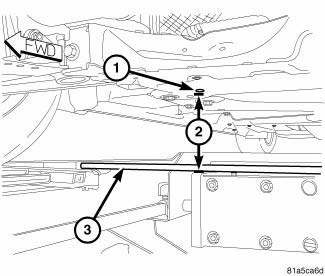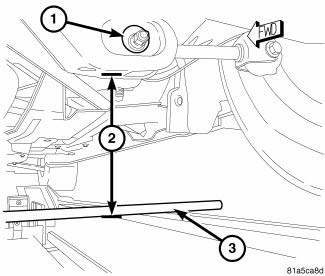Dodge Journey: Curb height measurement
The wheel alignment is to be checked and all alignment adjustments made with the vehicle at its required curb height specification.
Vehicle height is to be checked with the vehicle on a flat, level surface, preferably a vehicle alignment rack. The tires are to be inflated to the recommended pressure. All tires are to be the same size as standard equipment.
Vehicle height is checked with the fuel tank full of fuel, and no passenger or luggage compartment load.
Vehicle height is not adjustable. If the measurement is not within specifications, inspect the vehicle for bent or weak suspension components. Compare the parts tag on the suspect coil spring(s) to the parts book and the vehicle sales code, checking for a match. Once removed from the vehicle, compare the coil spring height to a correct new or known good coil spring. The heights should vary if the suspect spring is weak.
NOTE: Prior to reading the curb height measurement, the front and rear of the vehicle must be jounced to settle the suspension. Induce jounce by pushing down on the center of the bumper (fascia), using care not to damage the vehicle, moving the vehicle up and down, gradually increasing the suspension travel with each stroke. Release the bumper at the bottom of each stroke, repeating this action several times. Perform this to both front and rear suspensions an equal amount of times.
Measure curb height as follows:
1. Jounce the vehicle. Refer to above note.

Fig. 109: Front Curb Height Measurement
NOTE: On some vehicles it may be necessary to remove an engine belly pan in order to gain access to the lower control arm pivot bolt.
2. Front - On each side of the vehicle, measure the distance (2) from the flat surface behind the PLP hole (1) to the floor or alignment rack/lift runway surface. It may be necessary to measure to the bottom of a straight edge (3), placed from lift runway to runway, to get an accurate measurement.

Fig. 110: Rear Curb Height Measurement
3. Rear - On each side of the vehicle, measure the distance (2) from the flat surface below the rear toe adjustment cam bolt (1) to the floor or alignment rack/lift runway surface. It may be necessary to measure to the bottom of a straight edge (3), placed from lift runway to runway, to get an accurate measurement.
4. Compare the measurements to specifications listed in the following CURB HEIGHT SPECIFICATIONS chart. Maximum left-to-right differential is not to exceed 12.5 mm (0.5 in.).
5. If curb height is found to be out of specification and there is no sign of excessive body damage, curb height can be changed by replacing the applicable spring with a spring offering a different check load.
CURB HEIGHT SPECIFICATIONS

CURB HEIGHT SPECIFICATIONS - EXPORT

 Wheel alignment
Wheel alignment
PRE-WHEEL ALIGNMENT INSPECTION
Before any attempt is made to change or correct the wheel alignment, the
following inspection and necessary
corrections must be made to the vehicle to ensure proper ...
See also:
Diagnosis and Testing
BRAKE LAMP SWITCH
WARNING: To avoid serious or fatal injury on vehicles equipped
with airbags, disable
the Supplemental Restraint System (SRS) before attempting any steering
wheel, s ...
Description
Fig. 1: 2.7 Liter Engine
The 2.7 Liter (167 Cubic Inches) 60 degree V6 engine is a double overhead
camshaft design with hydraulic
lifters and four valves per cylinder. The engine does not have p ...
Description
Fig. 422: Identifying Torque Converter Components
- TURBINE
- IMPELLER
- HUB
- STATOR
- CONVERTER CLUTCH DISC
- DRIVE PLATE
The torque converter is a hydraulic device that couples t ...

